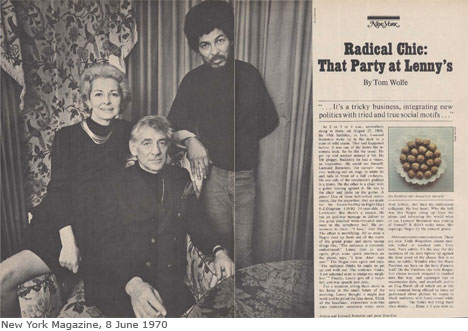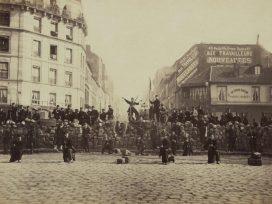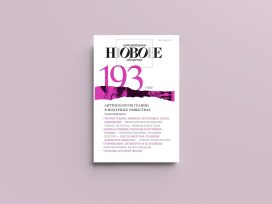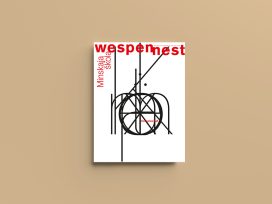Even the most practical revolutionaries will be found to have manifested their ideas in the aesthetic sphere.
Kenneth Burke, 1936
Newness and the aesthetico-political
A discussion of “radical chic” – a term used to denounce criticism and radical thought as something merely fashionable – is, to some extent, a discussion of the new. And while the merely fashionable is, in spite of its pretensions to be innovative and new, still conformist and predictable, being radical is the (sometimes tragic) attempt to differ. Such attempts to differ from prevailing (complacent, bourgeois) agreements are strongly dependent on the jargon of novelty. Therefore we find overlapping dimensions of the aesthetic and the political in the concept of the new.
The new itself, a key concept of aesthetic modernity, however, has not always been fashionable. And the category of the new is of course nothing new itself. The new fills archives, whole libraries – and that is, somehow, a paradox in itself. Generations of modernist aestheticians were dealing with the question: why is there aesthetic innovation at all, and how is it possible?
With the post-historical exhaustion of history the rejection of the new was cause for a certain satisfaction. Boris Groys argues that:
the discourse on the impossibility of the new in art has become especially widespread and influential. Its most interesting characteristic is a certain feeling of happiness, of positive excitement about this alleged end of the new – a certain inner satisfaction that this discourse obviously produces in the contemporary cultural milieu.
The malicious denial of the possibility of the new represents the very idea of the philistine: the self-sufficiency of ever-repeating sameness. In this sense, the new has been contested to denounce any claim to possible change. And in this perspective, again, any devaluation of the new has strongly political dimensions. But this gesture is not only a politically conservative gesture; it is also an anti-aesthetic gesture. As the aesthetic deals with identifications that become problematic, dynamic, too overly complex to be reduced to merely one name, concept or position, the new is just one of its many names. For these reasons, the new structurally unites the political vanguard with the aesthetic avant-garde, since both are struggling with the confinements of the given order of discourse in the quest for possible – if only symbolic – alternatives. And if aesthetic form, as the aesthetic tradition from Hegel to Bourdieu argues, at least to some extent materializes specific forms of life, the overlaps between the aesthetic and the political dimensions of novelty are even bigger.
Without openly political intentions, Boris Groys has theorized the new in structural terms – in opposition to all linear understandings of a teleological or utopian conception of it. According to Groys, the possibility of the new arises from the valorising practice of the culturally-dominant archives, and is not dependent on anything transcendent. The new is the fragile counterpart of the institutional orders of what already exists. Groys argues that by collecting, organizing and presenting the past in a structured manner, the process of valorisation implies the continuous production of the profane and thus the possibility of the new. The new is, thus, a limit concept of the archive, its immanent other.
Such a structural approach to (the question of) the new is fundamentally agnostic. The new does not fall from the sky; it is not unconditional; it is the outcome of practices of distinction. And so Groys’ theory allows for socio-theoretical readings. Since the new is rooted in forces that are fully terrestrial, its possibility stems from changing relations between the existing rather than from the invention of something purely unseen.
Speaking strictly about the aesthetically new, Adorno writes in Aesthetic Theory: “Artworks say what is more than the existing, and they do this exclusively by making a constellation of how it is.” The term constellation, however, is telling. It means to bring things in different conjunctions, to rearrange aspects of what already is. Adorno describes the new as the reflection of unforeseen constellations, alliances and conjunctions between existing lines of discourse. Such encounters between different lines of empirical reality allow for new perceptions. The new is, in other words, an effect of the combination of perceptions that had previously been separated, and that previously seemed to have their proper place. It is the impossible constellation of the possible.
Especially when the new is reconstructed in these terms, the implicit assault contained within the term “radical chic” appears as the sarcastic rejection of all this. And the history of the term “radical chic” is, as much as the general target of its critical insinuation, not quite so unproblematic: it functions as a fixation of social and discursive positions and as a foreclosure of the new – of unlikely social constellations that make things, previously unrepresented by the dominant lines of cultural representation, appear in a new light.
Some of this polemic is already present in the term “chic”. As an imported word, the word “chic” alludes to the (apparently French) world of fashion, with all its affectedness and its own inherent temporality of newness. To judge something as chic means to classify it as being in agreement with the latest developments of fashion. That is why “chic” might not even be an aesthetic but rather a cognitive or empirical judgment, a classification rather than a judgment of taste. To be “chic” means to be en vogue and to conform to the latest standards of fashion.
Classically, throughout the history of modernism, the idea of the aesthetically new attempted to distinguish itself from the empty temporality of the merely fashionable. Aesthetic newness had to differ from the “eternal recurrence of the new” in commodified culture. It continuously had to reinvent its own logics instead of merely repeating the dynamics of marketable innovation. The aesthetically new was, in other words, never only “chic”.
Something radically critical was implicit to the construction of the aesthetically new, a political ambiguity to newness itself. Most ambitiously the new could be understood as the very potential to reset the standards of perception, to introduce new logics of the empirical order.
In such a light, “radical chic” appears to be oxymoronic. But the line between fashion as conformism and fashion as an ambivalent field of political semiotics is not always sharp. It is certainly blurred in the example of “radical chic”.
Tom Wolfe’s radical chic and the ideology of distinction
In common usage, the term “radical chic” is used as provocation, or as a mere expression of privilege: “Radical chic” is upper-class style that feigns interest in any change without sufficient consistency. It is not too hard to imagine contexts in which this radical stance of complacent snobs can be found. The ever-repeating semiotic revolts of metaphysical leftism and of the newest “radical cultural theories” exemplify this very well. But something still seems to be wrong about the term.

The expression “radical chic” was coined by Tom Wolfe in his essay “Radical Chic: That Party at Lenny’s”, published in 1970. Wolfe’s satirical text deals with Leonard Bernstein’s fundraising party for the Black Panther Party in his 13-room Park Avenue penthouse duplex – shortly after the shooting of the 21 year-old Black Panther-activist Fred Hampton. This is Wolfe’s “funniest and sharpest essay”, as critics remark.
The scenario of this rather unlikely encounter between contrary social groups is already the plot of his reportage. Wolfe’s text is, all in all, a collection of sarcastic “observations”, an account of situations rather than a real story. It focuses on cultural distinctions and differences in status. It gives an atmospheric description of the discussions at the party (on charity and revolution), the food (Roquefort morsels) and, to a small extent, also the pre-history of these spontaneous alliances between bourgeois artists and radical activists (Wolfe does, for instance, refer to a 1969 party given in solidarity with a vineyard worker strike by politician Andrew Stein).
The text ends with a scene in a concert hall in which Bernstein finds himself confronted with a jeering audience. Wolfe interprets the jeering as reaction to the alleged symbolic damage that Bernstein’s flirt with the Panthers might have caused. He ironically imagines Bernstein’s perception of the audience’s response somewhere between nightmare and a final confrontation with reality:
Boooooooo! Booooooooo! It was unbelievable. But it was real. These greengrocers – he was their whipping boy, and a bunch of $14.50 white-throated cretins were booing him, and it was no insomniac hallucination in the loneliness of 3 a.m.
Finally, Bernstein gets the punishment he deserved for playing with fire. But Bernstein’s reaction to the jeering is still marked by class arrogance.
This is the general objection implicit in Wolfe’s texts: Radical chic is a merely apparent identification with the lower classes and radical politics. As Ronald Weber has pointed out, Wolfe introduces “radical chic” as a
means of asserting distance from prosaic middle-class life. In the case of Radical Chic in fashionable New York in the late Sixties nostalgie de la boue involved a fascination with revolutionary political styles as a way of demonstrating emancipation from the cautious consensus, the humdrum majority.
Wolfe emphasizes two rules of “radical chic”. One rule is the dependency on servants, which, of course, makes the whole radicalism appear inconsequent and phoney. But the specific problem with such a stylish radicalism of socially privileged groups is not the fact of privilege. Servants alone do not arouse any criticism. The complaint does not concern social inequality as such. Wolfe’s problem much rather seems to be that social elites misbehave and fall out of place. Yes, they have servants, so what? But culturally, they do not act accordingly. That makes them seem strange.
For this is the other “rule” of “radical chic”: Wolfe speaks of “radical chic” as of a “nostalgie de la boue”, as an, if you will, dialectical effect of a certain estrangement. In this sense the term “nostalgie de la boue” is well chosen. As “nostalgie” (“nostalgia” or melancholic longing) suggests, the inherent longing aims at something that has been lost. Yet “boue”, mud or dirt, emphasizes the primitiveness of the social contexts that were left behind. Thus, the term has a disciplinary character: Political critique is reduced to civilizational critique and civilizational critique is ridiculed as a desire for mere regression. Radicalism is thus dismissed through exaggeration, as some kind of a progressio ad absurdum.
In terms of genre one might want to describe Wolfe’s Radical Chic as a satire or a satiric pastiche. But the distinction between parody and satire is not stable and various theorists have accentuated quite different distinctive criteria. In her influential theory of parody, Linda Hutcheon distinguishes as follows: “parody is not extramural in its aim; satire is.” And, rephrasing Winfried Freund, she writes “satire aims at the restoration of positive values, while parody can only operate negatively.” Wolfe’s essay is caught between exactly these poles – between parody and satire, and between immanent and “extramural” critique on the one hand; and between the destructive gesture of critique and the restoration of positive values (such as the previously mentioned common sense of the moral majority, the individual strife for status etc.) on the other.
A critical look at Wolfe’s essay might be helpful to understand how to shift from an extramural position to a positive appropriation of the term: For “radical chic” could be the name for the impossible encounter between different social and political positions, for the fusion of styles that renders an indirectly political meaning. I will come back to such an approach later. But these are the things that are implicitly denounced.
The term “radical chic” is satirical, used in a strictly pejorative fashion. That, again, allows for a determination of the genre of Wolfe’s text. Satire, Robert S. Lehman writes, “insists on a division between itself and its literary-historical object.” And in that sense Wolfe’s essay seems to be extramural from the very beginning. If para- (as in parodia) means both, “alongside” and “against”, “alongside” plays the smaller part in Wolfe’s text, if any at all. The project of political transgression, of emancipatory encounters is hardly taken seriously at all. And if extramural means that it is argued form the perspective outside the bastion walls of radical critique, beyond its own textuality, then it would be a worthwhile undertaking to move inside, or at least to consider what that could mean. Wolfe, however, identifies only apparently with the speakers when he arranges their voices from the external perspective of an omniscient author.
What he finds on their minds is what he had known before: Egoism, narcissism, and self-staging. When he mockingly stylizes dialogues and inner monologues, ironically presenting the alleged ideas of the “radical chic”, he satirically denounces:
No tax deduction! That became part of the canon of Radical Chic. Lay it on the line! Matrons soliciting funds for Friends of the Earth and other organizations took to making telephone calls that ended with: “All right, now, I’ll expect to see your check in the mail – and it’s not tax deductible.”
The structure of Wolfe’s argument is a general denial of newness. In the end, political commitment is blamed for being conformist itself: “it is only radical in style”. Its claim to newness is nothing but the veil of an (apparently) eternal anthropological struggle for individual benefit – a world in which the tax return and the hairdo count more than manifestos. The radical posture of the trendy elites thus remains committed to “Society and its traditions”, to the apparently eternal strife for individual status, for distinction and, thus, conformist newness. Apparently, “chic” cannot be radical.
Wolfe’s politics of style
Wolfe may be a good writer. Certainly he is conscious about style and its use for his political agenda. His general tone of mimicking and mocking is subtly scandalizing as it assumes generally agreed upon rules. The laughing reader always finds himself in agreement with the “eternal codes” of distinctive practices, subtly being restored through stylistic suggestions.
Wolfe’s text is insinuating, alluding to the proper sentiments of a moral majority without ever making its own position explicit. When he mocks the encounter of different social classes and different cultural and ethnic backgrounds as something that does not seem right, he relies on different populist affections that he never has to address explicitly.
Status is the central category of his analysis, status as a form of stylistically produced social importance. Wolfe “concentrates on how status considerations shape even the most serious social activities”. And status is not understood in terms of power (the power to define what’s right and wrong, the power to install an order due to one’s own interests). It is rather understood in terms of “trendy cultural standards” from which one might “derive self-gratification”. The overly stylized prose of Wolfe serves as an example of its very claim. Anyone who might accuse Wolfe of narcissism falls into the trap of his argument: The consistency of a universe of individual style wars is precisely what he tries to prove. Such individualism, however, comes with its own dialectic; the objectification of major groups – sexism and racism – can be included without any difficulties. For wherever social struggle is interpreted as the individual striving for status (and wherever individuality is taken as something unproblematic, something that merely is), prevailing forms of prejudice against certain groups re-enter through the backdoor.
With Leonard Bernstein, of course, Wolfe chooses a Jewish artist (Wolfe tartly emphasizes how Bernstein insists on his Jewish background) as the personification of “radical chic”. It is Bernstein who invites black activists to his dinner party to an inappropriately big and luxurious apartment in the first place. Such ethnical tensions in the text are not without ambivalence. Apparently Wolfe outlines the antisemitism of the Black Panthers and aspects of Jewish self-hatred in history. His own depiction of the Jewish artist is, however, not really free from a stereotyping eagerness. Michael E. Staub observes a
strategic deployment of obviously Jewish names, references to gas chambers, to famously exploitative ghetto merchants, to Occupation zone commandants […] juxtaposed with extensive analytic passages explicitly elaborating on the complexities of anti-Semitism and the ways it might induce wealthy Jews to partake of radical chic.
As in previous populist narratives, dirty outlaws on the one hand and the properly adjusted but misguided “chic” people (intellectuals, artists, distinguished society) on the other are the targets of critique here. These targets of critique, however, were the paradigmatic enemies of German anti-Semitism as well: politicized proletarians and a bourgeois intellectual elite with no commitment to “national consensus”.
Wolfe puts quite some emphasis on nameless party guests, where social and gender categories replace the speaking subjects. A young woman who tries to understand the ideological background and political ideas of the Panthers in more detail is continuously called “ash blonde” – a category that reduces her to her gender position and ridicules her very attempt to care about politics at all. After a first failed attempt, she keeps insisting on her position, which Wolfe mockingly ridicules as her “bitchy” femininity:
Curiously, Ash Blonde doesn’t seem particularly taken aback by all this. If this dude in a pin-stripe suit thinks he’s going to keep her off The All-Weather Panther Committee, he’s bananas.
The emphasis on social positions is underlined by Wolfe’s emphasis on style, fashion and language. The “chic” is a fascination for an illegitimate way of speaking that Wolfe mimics. When African-American jargon is imitated, it appears as an inappropriate style, as language that is not yet a language in which legitimate claims could be expressed. Afro-Americans produce the noise of the street. Mocking Afro-American language, however, is a dangerous thing to do – Wolfe puts himself into a tradition, as Michael E. Staub has pointed out, of “infantilizing blacks”, a tradition “which goes back to slavery days”.
But Wolfe, again, hides behind the alleged attitude of the “radical chic” when he ridicules Afro-American dialect: A second-order mocking strategy, aiming at two enemies at the same time:
But everyone in here loves the sees and the you knows. They are so, somehow … black … so funky … so metrical … Without ever bringing it fully into consciousness everyone responds – communes over – the fact that he uses them not for emphasis, but for punctuation, metrically, much like the uhs favored by High Church Episcopal ministers, as in, “And bless, uh, these gifts, uh, to Thy use and us to, uh, Thy service”
This ridiculing tone, depicting deviation or currently new styles as inappropriate, characterizes all his descriptions of black culture and therefore, of course, that of black fashion, too. Wolfe speaks of “Afro Fuzzy Wuzzy” style and ironically emphasizes the connection between black and soul as the leading attribution of blackness in popular culture (he refers, for instance, to a series of columns in Vogue dedicated to so-called “soul food”).
Wolfe’s stance is comfortably simple. As he projects and produces what might never have been implied he produces the sameness of a value structure that is fundamentally his own. Wolfe moves “subtly and cleverly from perspective to perspective – none of them completely his own nor identifiably anyone else’s”. Through the formulas of sameness through which he presents the underlying logic of cultural practice, he generalizes and perpetuates the values and styles that he chooses to generalize. That is one of the – fairly paradoxical – political agendas of his style: he installs an anonymous subjectivity with the most stylized, and thus most subjectivist, means. The interpellation of subjects operates through their denial so that the principles of subjectivity can operate silently.
Alternative voices are, if prominent, personalized but de-subjectified in yet another way: when Wolfe speaks of Leonard Bernstein he only refers to him as “Lenny”. He is degraded to a mere fellow, to a mere first name, even a nickname, as if the fact that he gives a party at which black militants are present, makes him a less qualified, less distinguished citizen, not worthy of being addressed by his family name, a mere “comrade”, part of a pre-individuated mob. Michael E. Staub has emphasized how this also comes with suggestions of queerness, femininity and exaggerated sensuousness. Being subjectified is a question of gender, too. “Lenny” isn’t in his proper place and deviation from the mythical order of sameness will encounter the Wolfean smirk.
Wolfe doesn’t only postulate his anthropology of fashion, status, and commerce. He performs it; he tries hard to be the proof of the one and only principle that he claims to have found at the ground of the social order. In precisely this fashion the term “radical chic” (his own invention) is used as a brand name, a label. It is used frequently, around five times per page, around a hundred times throughout the text.
And not only that this gesture has something deeply narcissistic (an objection that would merely prove Wolfe’s central claims), its textual function and its implicit critique of politics as being indistinguishable from fashion and commerce is consistent. Such a commodified style binds elements of pastiche together in a plurality of voices, behind which a suggestive rhetoric hides. Behind the assemblage of voices and information a clear-cut moral judgment is present at all times, insinuating and suggesting the impossibility of the encounter it depicts.
As a strategically clever writer, Wolfe, of course, never makes explicit statements through which he could too easily be positioned. Before he wonders about Ash Blonde’s insistent interest in politics, he attributes the sexist attitude to other party guests, not having taken her seriously in the first place. The same goes for the implicit racism of “radical chic”. Wolfe’s genius consists in his atmospheric generalization of sexist and racist attitudes that simply seem to be “around”.
But all kinds of parody, persiflage and satire are of a strange form of complicity. To mock means to mimic, to challenge, to unmask. But what if the image that one gives when one mocks is no longer a distorting image, but rather a simulation, a new reality of its own kind? What if the parody is in fact much less parasitical than it claims to be? What if it were in fact productive, active, and creative? What if texts were productive rather than representational? Simply put: In Wolfe the literary gesture of “mocking”, parody and persiflage is hardly to be distinguished from, generously speaking, the mere repetition and stabilization of the attitudes that it pretends to denounce. Wolfe in fact only mocks to emphasise the underlying sameness in the apparently new.
Radical chic between habitus and field
Wolfe has been commended for the precision of his observations and even for sociological depth. But what is the theoretical agenda of such an approach? And how valid is Wolfe’s essayism in sociological terms?
There seems to be a certain affinity between the denouncing gesture of Wolfe’s essay and the cultural sociology of Pierre Bourdieu. The main argument of Bourdieu’s Distinction also appears to unmask apparent and conspicuous forms of critique and cultural transgression as practices of status confirmation. In light of empirical analysis of aesthetic preferences, all kinds of avant-gardist transgression appear to be merely “chic” – a mere means to social distinction. Being “chic” appears as a mere question of habitus, and radicalness is one of its means.
Pierre Bourdieu does not only provide a theoretical vocabulary to make sense of Tom Wolfe’s project of dismissal. Here and there he even refers to the terminology of “radical chic”. “Radical chic”, he writes in the Scholastic Point of View, offers “all the benefits of apparent subversion, […] while at the same time leaving everything as it is.”
But even from a rather cynical interpretation of Bourdieu’s perspective Wolfe’s denunciation appears somewhat deficient if not openly opposed to Bourdieu’s theoretical project. If the whole dynamics of cultural innovation is built upon attempts to Distinction, as Bourdieu’s most important work seems to suggest, the mere rejection of the distinctive strategies of the educated bourgeoisie and its alliances with avant-gardist outcasts would be a (both aesthetic and political) strictu sensu reactionary position. Whatever the inherent forces to cultural innovation are, Bourdieu does not dismiss it. Nor does he see it as merely apparent. The aesthetic practice is a practice of its own kind, operating according to its own standards.
In light of one of Bourdieu’s most powerful terms, the concept of symbolic violence, other nuances appear that allow differentiation between the projects of Wolfe and Bourdieu. Bourdieu uses the term symbolic violence to accentuate the naturalization of social positions and the de-legitimization of alternative practices and lifestyles. In a sense, Wolfe does indeed manage to critically outline dimensions of symbolic violence. He might even have a point where he critically depicts Bernstein’s attempts to tame the political practice of the Panthers, trying to depoliticize his own support as mere charity. For charity, of course, is a patronizing gesture that keeps symbolic hierarchies intact. Wolfe reminds us of this misunderstanding as he reports Leonard Bernstein’s party guests’ insistence on community programs. And by doing so, he presents the fundraiser as an act of class arrogance even in the apparent acts of generous solidarity.
But, again, it is hard not to read his text as the perpetuation of symbolic violence itself. Wolfe writes his piece for a well-established magazine and his critique is also an attempt to establish standards of legitimate taste and style. And when “the dominant groups endeavour to impose their own life-style […] in the glossy weekly magazines”, Bourdieu writes, “there is terrorism in all such remarks, flashes of self-interested lucidity sparked off by class hatred or contempt.”
In Wolfe’s text this moment of contempt is not always subtle and indirect; it does not always operate through the denigration of (apparently inappropriate) style. It also openly ironizes and denies the claim to equal rights. Given the sharp and polemic tone of it, one of the meanest (and therefore also ugliest) parts of Wolfe’s text therefore is the passage in which he quotes the aims of the Panther’s Field Marshall Cox: “All we want is the good life, the same as you. To live in peace and lead the good life, that’s all we want … see …” And of course this simple and humane claim appears to be the most absurd of all political ideas when addressed at millionaires in a Park Avenue penthouse apartment.
All such attempts to present unlikely political alliances – as simple and democratic their claims might be – as absurd, naturalize the social reality of class dominance. The plurality of voices is false semblance, masking a secret normative logic, a logic that puts social agents in their apparently natural social position and makes sure that they stay there. To Wolfe plurality is the veil in front of eternal sameness.
And if the attempt to be chic and to advance in status is the main principle of that sameness, why is being chic denied the right to being politically radical? Why should there be a fundamental abyss between fashion and politics? “Radical chic”, that is part of the Wolfean smirk, is blamed for mistaking politics for fashion, for mistaking the “chic” as the radical.
But what is so ridiculous about such a convergence, about fashionable politics and political fashion? Just like any symbolic practice, fashion communicates codes of social significance. It transmits social meaning through which changing constellations of social consent are silently confirmed. Or, to even go one step further, if political (theoretical, practical) radicalism were not culturally attractive in some sense, it would not have a chance to become influential at all. “Radical chic”, in some sense, is a strategic necessity. This is a simple claim shared by all theories of hegemony and one could argue like this from the perspective of Bourdieu, too. Symbolic capital – the “legitimate” currency of social articulation – is always also object to struggle. The legitimization of specific forms of habitus is, therefore, necessarily political; it goes through fashion and style, through hairdos and (body-) language. It constitutes the symbolic side of politics – no real reason to denounce “radical chic” here either. The “chic” and the politics of stylistic codes cannot easily be separated. “Radical chic” is not necessarily an oxymoron.
But the main argument that separates Bourdieu from the polemic against “radical chic” is another one. The most important failure of Wolfe’s implicit class analysis is the fact that he is not actually dealing with the purely dominant class. Bourdieu’s twofold analysis of class is more differentiated and therefore also helpful to understanding the possibility of the shifting political alliances, in which intellectuals are involved. Intellectuals, owners of cultural rather than economic capital, are, as Bourdieu emphasises, both dominant and dominated. On the one hand in possession of cultural capital and of a higher symbolic status, on the other hand, they still depend on economic means, and are therefore still dominated. The intrinsic logic of intellectual and artistic production is therefore dependent on a struggle with prevailing norms that would finally allow for some autonomy of the respective fields. The autonomy of the field is an effect of conspicuously non-conformist attitudes.
Revolutions [or aesthetic innovations, JFH] are incumbent on those hybrid and unclassifiable beings whose aristocratic dispositions, often associated with a privileged social origin and with the possession of large symbolic capital […] underpin a profound “impatience with limits”, social but also aesthetic limits, and a lofty intolerance of all compromises with the times.
This is one of the main observations of The Rules of Art whose secret hero, Gustave Flaubert (less radically but more successfully than Baudelaire) establishes himself as a paradigmatically non-conformist just because of his schizophrenic position in the salons and in non-conformist discourse. The development of an innovative lifestyle that seemed provocative to the bourgeoisie was, strictly speaking, “chic”. It also allowed for spontaneous alliances with “the people” and allowed for distance from the dominant alliances in the political and economic field. Yes, we could say, this is “radical chic” avant la lettre and the whole autonomy of the intellectual field heavily relies on it. “Radical chic” has structural reasons other than the individual strife for status and cultural distinction. Its logic is part of the constitution of the artistic field.
Radical chic as subjectification and aesthetic dissent
So, to put it more simply: Why should Panthers not eat Roquefort morsels at Park Avenue? Isn’t this in fact a, strictly speaking, beautiful idea?
The aesthetico-political efforts of Jacques Rancière indeed suggest that they actually should. There basically are the two main arguments that Rancière contributes to our discussion. (a) The first one concerns the aesthetico-political logic of subjectification. Wolfe’s text relies on the populist hatred of any form of inappropriate social encounter. Stylistically, this merges with two dimensions of de-subjectification. Alternative voices are mocked, ridiculed, infantilized and presented as pre-subjectified. Their sound is deviant, feminine, gay, adolescent and thus, not legitimate. At the same time social positions replace human agents, human agents appear as mere functions of their social status and gender position. And, according to Rancière, such strategies of denigration have to be regarded as crucial. The “whole question”, as one could state with Rancière, “is to know who possesses speech and who merely possesses voice.”
Reducing persons to their social position has, of course, been a critical gesture in leftist theories, too. It emphasizes the structural boundaries of individual self-realization or critical praxis. But there is always also something reactionary about it – as it fails to acknowledge the potentials of sensuous encounters between different social regimes. Rancière’s critique of Bourdieu has aimed at precisely this problem: that the critical gesture of unmasking the underlying, ever-same principles can contribute to their perpetuation, too.
If there is, however, a productive relation between the aesthetic and the political that allows for newness, it is, as Rancière has emphasized, precisely in the reorganization of the field of legitimate speech, in the moment of falling out of one’s position. The confrontation of different logics of the aesthetic will allow for a subjectification that surpasses the pre-stabilized harmony of social positions. This is the rare moment of authentic politics, a redistribution of the temporal and spatial order of legitimate speech:
Politics occurs when those who ‘have no’ time take the time necessary to front up as inhabitants of a common space and demonstrate their mouths really do emit speech capable of making pronouncements.
Such a politics is, as Rancière has emphasized, aesthetic in more than one respect: It reorganizes the social regulations of perception and of articulation. And it operates in and through several media and semiotic regimes. It is not only linguistic (cognitive, epistemic); it is also aesthetic.
Rancière’s second argument (b) is closely linked to the first. If subjectification is but another name for the act of leaving one’s social position, then it is in the encounter of different sensuous regimes where aesthetic practices find their vital source.
Rancière’s second argument concerns the social dynamics of newness. Sensuous regimes are socially concrete – as perceptive and semantic frameworks – and they are given in specific social contexts, in specific social groups, strata, and classes. Therefore the possibility of subjectification, the emphatic idea of politics is contingent on social encounters.
Rephrasing the aesthetic heritage (of sensuous dynamics, shifting identities, and experimental openness) in social terms, this simply means to take a stand for “radical chic”. Or, negatively put, keeping social positions in place and outsiders outside is, thus, not only a politically reactionary but also a non-aesthetic gesture.
In that sense aesthetic dissent is precisely the possibility of a “fuzzy-wuzzy” Afro-hairdo and illegitimate forms of language at Park Avenue. And it is this encounter that allows social agents to move beyond their social position.
Just as workers can read and write poetry or even lead the life of a dandy (as in Rancières most famous examples) politicized snobs and aestheticized revolutionaries incorporate political ambiguities that can be of some interest. For if “the emancipation of the worker”, as Rancière writes (1995, 51), “entails a style of living, an aestheticization of his life”, then alliances with “chic” cultural elites can be productive in some respect. It is the moment of unlikely social encounters that bring to the fore elements of the emphatically new that tend to be suppressed by the logics of social positioning. Panthers who eat Roquefort morsels in Park Avenue are allegories of such an encounter.
Its critique is therefore at all times a critique of both the modern constitution of aesthetic practices as of emancipatory politics, of newness, the struggle for the autonomy of the aesthetic field, of sensuous encounter, and, more boldly put: of aesthetic subjectification. And if any political project wants to realize itself, it also has to occupy the realm of the aesthetic, to enter the struggle for the possession of the logic of the new. Radicalism that is only chic might not be enough, but if radicalism does not become chic it has no chance of becoming socially meaningful. The radicalism of the drawing room is better than none. Why not take aesthetics seriously and be both radical and chic? Why should we not, in other words, invest effort in re-politicizing the new?







